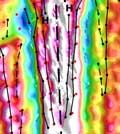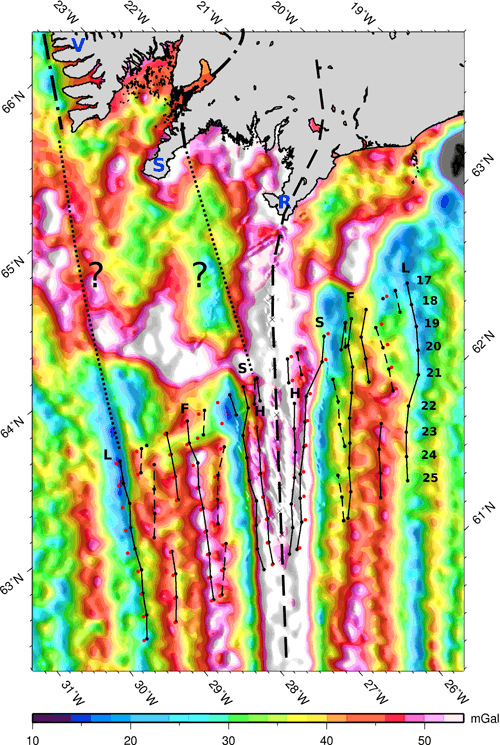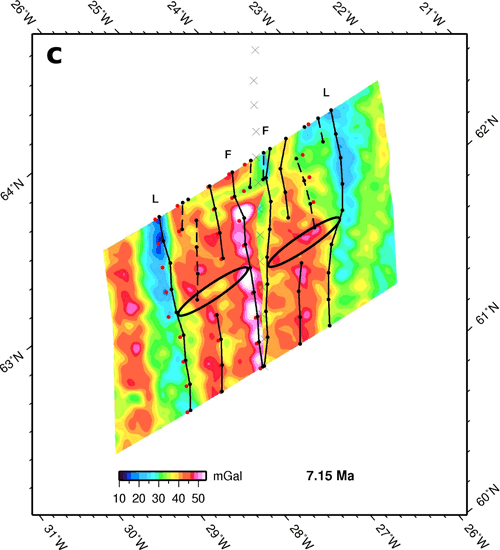 |
Evolution of the Reykjanes Ridge during the past 15 Ma |
Ásdís Benediktsdóttir1, Richard Hey2, Fernando Martinez2 and Ármann Höskuldsson3
1Formerly: Department of Geology and Geophysics, University of Hawai‘i at Mãnoa, 1680 East-West Road, Honolulu, Hawaii 96822, USA; Currently: Nordic Volcanological Center, Institute of Earth Sciences, University of Iceland, 101 Reykjavik, Iceland, asb1@hi.is
2Hawaii Institute
of Geophysics and Planetology, School of Ocean and
Earth Science and Technology, University of Hawaii,
Honolulu, HI 96822 USA, hey@soest.hawaii.edu ; fernando@hawaii.edu
3Institute of Earth Sciences, University of Iceland, 101 Reykjavík, Iceland, armh@hi.is
This webpage is a summary of: Benediktsdóttir, Á.; Hey, R.; Martinez, F.; Höskuldsson, Á., Detailed tectonic evolution of the Reykjanes Ridge during the past 15 Ma, Geochem. Geophys. Geosyst., 13, Q02008, 2012.
Iceland is an island 103,000 km2 in area, lying between the Kolbeinsey Ridge in the north and the Reykjanes Ridge (RR) in the south. There is, without doubt, something anomalous causing Iceland. We, the authors, do not know whether it is a conventional "hot spot" (a pretty vague term) or something else. We therefore choose to call it the "Iceland anomaly".
The effect of the Iceland anomaly is seen on the RR. This is a slow spreading ridge and instead of having an axial valley, like most slow spreading ridges, it has an axial high. Furthermore it spreads in a direction 30° oblique from perpendicular to the ridge, and straddling its flanks are the infamous V-shaped ridges (VSRs).
Previously, conventional wisdom was that RR seafloor spreading and the VSRs were symmetric, but in his web article, which followed our first paper on this subject (Hey et al., 2010), one of us, Richard Hey, described the asymmetry of this area. The most widely accepted explanation for asymmetric ridge accretion world wide is the propagating rift hypothesis (see, for example, Hey, 1977; Vogt et al., 1983; Naar & Hey, 1991; Kleinrock et al., 1997).
Detailed modeling of the magnetic anomalies on the RR between 63.00N -24.68W and 61.8N -26.78W revealed its tectonic history for the past 15 Ma in the context of propagating rift history. We used data from 9 profiles parallel to the ridge spreading direction and obtained a self-consistent rift propagation model for the RR for the past 15 Ma (Benediktsdóttir et al., 2012). The evolution of the rift propagation model for the RR can be viewed schematically in a video posted on YouTube (please "like" us!) at http://www.youtube.com/watch?v=JCfGhXxKMdo&feature=relmfu and overlain on gravity derived from satellite altimetry (Sandwell & Smith, 2009) at http://www.youtube.com/watch?v=KDIhK68OqAw.
Further information on these YouTube videos:
First video: Cartoon showing the evolution of the Reykjanes Ridge. Horizontal axis is distance from ridge and vertical axis is distance from the Reykjanes Peninsula. Green lines connect the pseudofaults of northward propagators. Blue lines connect the pseudofaults of southward propagators. Red dots are failed rifts. L, Loki; F, Fenrir; S, Sleipnir; H, Hel.
Animation overlain on Sandwell & Smith (2009) satellite gravity: Pseudofaults (black circles) are connected by solid and dashed lines for southward- and northward propagators, respectively. Red circles are failed rifts. For each time the gravity is gridded in the area bounded by 19 Ma, the current time, and profiles 17 and 25 on each ridge flank. The two areas are then rotated toward each other to close the space between the ridge and the areas. L, Loki; F, Fenrir; S, Sleipnir. |
The results imply that propagation can occur both toward and away from Iceland and that the southward propagators are generally bigger and longer-lived than the northward ones. The offset between the dying and propagating rifts was small in all cases for the propagators we identified on the RR (between 1 and 10 km). This is smaller than many of the best identified propagators elsewhere (i.e., the 95.5°W propagator in the Galapagos, where the offset is ~25 km). Figure 1 shows a schematic of the present day pseudofault and failed rift configuration, as indicated from our study, superimposed on free air gravity from satellite altimetry (Sandwell & Smith, 2009). The important outcome of this study is a self-consistent tectonic model of the RR derived from magnetic anomalies. Interestingly, the short-lived propagators seem to originate from, or stop at, flowline-parallel discontinuities in the gravity. One of these can be seen, for example, in Figure 1 between the two oldest, southernmost, short-lived propagators (circled in Figure 2).

Figure 1: Satellite gravity and tectonic boundaries near Iceland (Sandwell & Smith, 2009). Oblique Mercator projection. Pseudofaults and failed rifts predicted by our magnetic models are shown. Solid lines connect the pseudofaults of southward propagating rifts, dashed lines connect pseudofaults of northward propagators, and red dots are failed rifts. Heavy dashed line is the Reykjanes Ridge and its extension up to Iceland. Dash-dotted lines are the locations of the paleo-spreading centers in Iceland and dotted lines are an attempt to trail the paleo-spreading centers down to our survey area. Numbers indicate the location of our profiles (17–25). V, Vestfirðir; S, Snæfellsnes; R, Reykjanes Peninsula; L, Loki; F, Fenrir; S, Sleipnir; H, Hel.

Figure 2: Snapshots of the evolution of the Reykjanes Ridge after the propagation of Fenrir. Overlaid on satellite gravity (Sandwell & Smith, 2009) are pseudofaults (black circles) connected by solid and dashed lines for southward and northward propagators, respectively. Red circles are failed rifts. For each time, the gravity is gridded in the area bounded by 19 Ma, the current time and profiles 17 and 25 on each ridge flank. The two areas are then rotated toward each other to close the space between the ridge and the areas. Time of each snapshot is indicated by the number in the lower right corner. L, Loki; F, Fenrir; S, Sleipnir.
When the VSRs are studied in more detail it is clear that they are not symmetric about the RR. They are more pronounced (have a higher amplitude) on the North American plate and there is a large bend in the oldest trough on the Eurasian plate, which we explain by a stalling propagator.
If the Iceland anomaly is pulsating, as is claimed in many papers (e.g., Vogt, 1971; Smallwood & White, 1998) then some extra process has to be added in order to explain the asymmetry in the structure of the VSRs. Simple pulsing alone cannot cause this. Rift propagation, on the other hand, can explain the observed asymmetry but it is not clear whether it can explain the V-shaped topographic and gravity anomalies. An important question then arises–are both mechanisms necessary, or can all the observaitons be explained by rift propogation alone? This question remains to be answered.
We noticed that the tectonic history of the RR becomes more complicated with increasing proximity to Iceland which suggests that the Iceland anomaly influences the evolution of the RR. This can be seen in Figure 3, where we plot the time of jump vs. distance to the Reykjanes Peninsula. The jump pattern is more complex close to Iceland and becomes simpler further away. The plate boundary on Iceland has experienced several ridge jumps, where the center of volcanism and spreading seems to shift toward the center of the Iceland anomaly (Saemundsson, 1974). The Eastern Volcanic Zone in Iceland is currently propagating south away from the Iceland anomaly. The general consensus is that this propagation is replacing the Western Volcanic Zone. Thus today we have an active eastbound lateral shift of the spreading centers on Iceland (Einarsson, 1991; La Femina et al., 2005). In this context one might wonder how this propagation behaviour extends into the oceans.

Figure 3: Time of jump from the magnetic models vs. distance from the Reykjanes Peninsula (63.67°N, 22.75°W) on Iceland. Red and blue circles correspond to jumps transferring lithosphere to North America or Eurasia, respectively. Arrows show direction of propagation. Solid lines are a linear interpolation of the southward propagating rifts extrapolated to the Reykjanes Peninsula. Heavy dashed line separates transitional profiles 17 and 18 from profiles 19 and south. Dotted lines are the locations of the two psuedo-transforms. Propagation rates are ~300 ± 50 km/Myr, ~120 ± 40 km/Myr, ~100 ± 10 km/Myr, ~60 ± 10 km/Myr and ~90 ± 10 km/Myr for Loki before the psuedo-transform, Loki after the psuedo-transform, Fenrir, Sleipnir and Hel, respectively.
In our current paper (Benediktsdóttir et al., 2012) we conclude that rift propagation occurs both toward and away from Iceland, explaining the observed asymmetric lithospheric accretion on the RR. Although there is more lithosphere added to the North American plate, consistent with eastward migration of the plate boundary on Iceland, we note that there are also propagators that transfer lithosphere to the Eurasian plate. Several small scale rift propagations are observed, including northward propagations, suggesting that the evolution of axial volcanic ridges complicates rift propagation evolution.
If "plume pulses" drive southward propagators, two different driving mechanisms for propagators must exist. Our rift propagation model, on the other hand, provides excellent fits to magnetic data, the simplest explanation, and a self-consistent model for the evolution of the Reykjanes Ridge during the past 15 Ma.
References
-
-
Einarsson, 1991, Earthquakes and present-day tectonism in Iceland:Imaging and understanding the lithosphere of Scandinavia and Iceland, Tectonophysics, 189, 261-279.
-
Hey, R. N., 1977, A new class of pseudofaults and their bearing on plate tectonics: A propagating rift model, Earth Planet. Sci. Lett., 37, 321–325, doi:10.1016/0012-821X(77)90177-7.
-
Hey,
R., F. Martinez, Á.
Höskuldsson,
and Á. Benediktsdóttir, 2010, Propagating
rift model for the V-shaped ridges south of Iceland, Geochem.
Geophys. Geosyst., 11,
Q03011, doi: 10.1029/2009GC002865,
-
Kleinrock, M., B. Tucholke, J. Lin, and M. Tivey, 1997, Fast rift propagation at a slow-spreading ridge, Geology, 25, 639.
-
La Femina, P.C., T.H. Dixon, R. Malservisi, Th. Árnadóttir, E. Sturkell, F. Sigmundsson, and P. Einarsson, 2005, Geodetic GPS measurements in south Iceland: Strain accumulation and partitioning in a propagating ridge system, J. Geophys. Res., 110, B11405, doi:10.1029/2005JB003675.
-
Naar, D. and R. Hey, 1991, Tectonic evolution of the Easter microplate, J. Geophys. Res., 96, 7961–7993.
-
Saemundsson, K., 1974, Evolution of the axial rifting zone in northern Iceland and the Tjornes fracture zone, Geol. Soc. Am. Bull., 85, 495-504.
-
Sandwell, D. and W. Smith, 2009, Global marine gravity from retracked Geosat and ERS-1 altimetry: Ridge segmentation versus spreading rate, J. Geophys. Res., 114, B01411, doi:10.1029/2008JB006008.
-
Smallwood, J., and R. White, 1998, Crustal accretion at the Reykjanes Ridge, 61?-62?N, J. Geophys. Res., 103, 5185-5201.
-
Vogt, P., 1971, Asthenosphere motion recorded by the ocean floor south of Iceland, Earth Planet. Sci. Lett., 13, 153-160.
-
Vogt, P., N. Cherkis, and G. Morgan, 1983, Project Investigator-I: Evolution of the Australia-Antarctic discordance deduced from a detailed aeromagnetic study, in Antarctic Earth Science, edited by R. Oliver, P. James, and J. Jago, pp. 608–613, Cambridge Univ. Press, Cambridge, U. K.
last updated 14th
May, 2012 |
